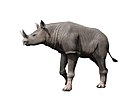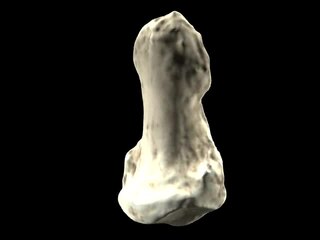
Orrorin is an extinct genus of primate within Homininae from the Miocene Lukeino Formation and Pliocene Mabaget Formation, both of Kenya.

Diceros is a genus of rhinoceros containing the extant black rhinoceros (Diceros bicornis) and several extinct species.

Dicerorhinus is a genus of the family Rhinocerotidae, consisting of a single extant species, the two-horned Sumatran rhinoceros, and several extinct species. The genus likely originated from the Late Miocene of central Myanmar. Many species previously placed in this genus probably belong elsewhere.
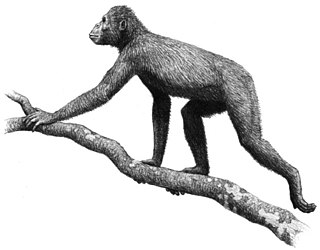
Proconsul africanus was an ape which lived from about 23 to 14 million years ago during the Miocene epoch. It was a fruit eater and its brain was larger than that of a monkey, although probably not as large as that of a modern ape.

Afropithecus is a genus of Miocene hominoid with the sole species Afropithecus turkanensis, it was excavated from a small site near Lake Turkana called Kalodirr in northern Kenya in 1986 and named by Richard Leakey and Meave Leakey. The estimated age of Afropithecus is between 16 and 18 million years old, which was determined with radiometric dating techniques and the geological studies conducted by Broschetto and Brown from the University of Utah. In total there are 46 recovered specimens from Kalodirr relating to Afropithecus consisting of cranial, mandible, dentition and post-cranial remains. The type specimen of Afropithecus turkanensis is KNM-WK 16999.

Rusinga Island, with an elongated shape approximately 10 miles (16 km) from end to end and 3 miles (5 km) at its widest point, lies in the eastern part of Lake Victoria at the mouth of the Winam Gulf. Part of Kenya, it is linked to Mbita Point on the mainland by the new Rusinga-Mbita bridge which replaced the old causeway.

Chilotherium is an extinct genus of rhinocerotids endemic to Eurasia during the Miocene through Pliocene living for 13.7—3.4 mya, existing for approximately 10.3 million years.

Samburupithecus is an extinct primate that lived in Kenya during the middle to late Miocene. The one species in this genus, Samburupithecus kiptalami, is known only from a maxilla fragment dated to 9.5 million years ago discovered in 1982 and formally described by Ishida & Pickford 1997. The type specimen KNM-SH 8531 was discovered by the Joint Japan-Kenya Expedition at the SH22 fossil site in the Samburu District, a locality where several other researchers found no ape fossils.

Euthecodon is an extinct genus of long-snouted crocodile. It was common throughout much of Africa during the Neogene, with fossils being especially common in Kenya, Ethiopia, and Libya. Although superficially resembling that of gharials, the long snout was a trait developed independently from that of other crocodilians and suggests a diet of primarily fish. Euthecodon coexisted with a wide range of other crocodiles in the areas it inhabited before eventually going extinct during the Pleistocene.
Maboko Island is a small island lying in the Winam Gulf of Lake Victoria, in Nyanza Province of western Kenya. It is about 1.8 km long by 1 km wide. It is an important Middle Miocene paleontological site with fossiliferous deposits that were discovered in the 1930s. The age of the deposits is estimated to be 15 to 16 million years, and they are especially important for the abundance of primate fossils they contain.
Victoriaceros is an extinct genus of elasmotheriine rhinoceros known from the Miocene of Maboko Island, Kenya.
Brochuchus is an extinct genus of crocodile known from the Early Miocene Hiwegi Formation of Rusinga Island in Lake Victoria, Kenya; it was originally named as a species of Crocodylus. It contains two species, B. parvidens and B. pigotti. Brochuchus belongs to the family Crocodylidae, which includes all living crocodiles. The closest living relative of Brochuchus is Osteolaemus, the dwarf crocodile. Compared to Osteolaemus, which has a small body and blunt snout, Brochuchus has a more generalized crocodylid anatomy. Brochuchus is characterized by a flat and relatively narrow skull, and although it is larger than Osteolaemus it is smaller than most other crocodylids. It has two prominent bumps on the surface of its snout.
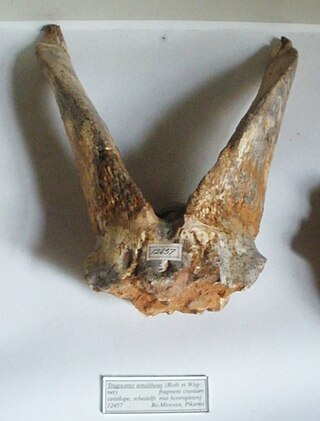
Tragoportax is an extinct genus of bovid ungulate. It lived during the upper Miocene, and its fossils have been found in Europe, Asia and Africa. Tragoportax is sometimes considered to have been a close relative of the extant nilgai, though it may have formed its own subfamily, along with Miotragocerus.
Micropithecus is an extinct genus of primates that lived in East Africa about 19 to 15 million years ago, during the early Miocene. The genus and its type species, Micropithecus clarki, were first scientifically described in 1978.
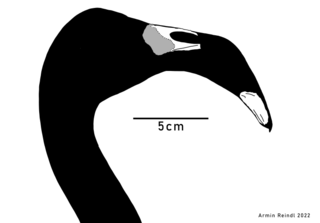
Leakeyornis is an extinct genus of flamingo from the early to middle Miocene of Kenya, primarily in the area of modern day Lake Victoria. Initially described as a species of Phoenicopterus based on an incomplete skull and various limb bones, it was later found to show a mixture of traits found across modern flamingo genera and subsequently placed in its own genus. It contains a single species, Leakeyornis aethiopicus.
Asilifelis is an extinct genus of small felid that lived in what is now Kenya during the Early Miocene. Despite its fragmentary remains, it is remarkable because of its small size and advanced dentition. It contains a single species, Asilifelis cotae.
Katifelis is an extinct genus of felids that lived in what is now Kenya during the Early Miocene and is notable for its dental features, which are intermediate between basal and modern cats. It contains a single species, Katifelis nightingalei.

Calumma benovskyi is an extinct species of chameleon of the Calumma genus. While species of this genus are only found on Madagascar today, C. benovskyi was discovered in the Miocene sediments of Kenya. This indicates that the genus and even chameleons as a whole did not originate on Madagascar, as often held previously, but on continental Africa. This matches with several prior studies that favor an African origin of the group both based on phylogenetic results and the ocean currents present between Africa and Madagascar during much of the Paleogene and Neogene. Additionally, since C. benovskyi was found to be a rather derived member of its genus, this would necessitate a much greater, as of yet unknown diversity of chameleons from the Oligocene and Miocene of Africa.

Chamaeleo intermedius is an extinct species of chameleon from the Miocene of Kenya. It was given its name based on the fact that it shares traits with both species of the genus Chamaeleo and those of Trioceros, which at the time were placed in the same genus. This belief that it was an intermediate form was however rejected by later research.
Parapliohyrax is an extinct genus of large hyracoid, a group today represented only by the diminutive hyraxes, but showing in fossil archives a large diversity in ecology and morphology. Parapliohyrax lived during the Miocene period, in various localities spanning the entirety of the African continent. Two species have been identified, based on cranial remains : Parapliohyrax mirabilis, the type species, known from the Miocene of Morocco and Tunisia, and P. ngororaensis, discovered in Kenyan and Namibian deposits. Isolated postcranial remains attributed to the genus have been identified in South African and Libyan deposits of the same age.






















